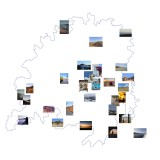The greek islands are one of the most popular summer holiday destinations, not only on a local but on a global level. Thus, tourism in Greece is a constantly growing economical activity. What happens when the number of visitors exceeds the island’s capability to accommodate them? The rising popularity of the islands, the last years, has reached a level where the identity of the island as well as the "tourism product”, meaning the quality of the visitor's stay there, are starting to change. In an effort to redefine the tourism model, we notice a change of direction to different type of holiday. We now see islands less popular, advertised as locations "non touristy" and "authentic" where the visitor can live like a local and enjoy the unspoiled landscape. What do we mean by "authenticity"? Which are its characteristics? How can someone live the real experience of a place? And what does it mean, for the place itself and for its people, all of the above, to become the elements of a new tourism campaign? Considering these questions, in this research a case-study is conducted on the island of Serifos, which has been characterized as an alternative holiday destination. After taking interviews, visiting the island, doing bibliographic research and collecting photographs, we attempt to understand the meaning of "authenticity" on this specific island. Is promoting this "authenticity" the answer to the overconsumption of tourism today and what are the consequences that this will come with?
